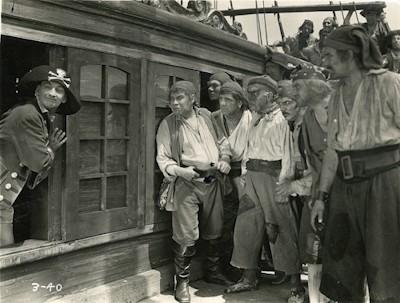 The popular images in film and literature of what pirates wore does not generally correspond to the reality of the period, and is usually based more on 19th century depictions. Howard Pyle drew many interpretations taken from a combination of contemporary South American dress and what 19th century seamen wore. Not a great deal is known about what pirates actually did wear as no pirates were directly painted by artists, but we can assume that most pirate crews were probably indistinguishable from other seamen of the time. Sailors clothes were known as slops and were cheap, baggy, and durable. Uniforms weren’t introduced until 1857. Jackets and trousers were often painted with pine tar to make them water resistant, giving sailors the name tars. Clothing was a much sought after and pirates would often steal it when a ship taken, so they usually wore the clothes of ordinary sailors supplemented by those stolen from more well-off victims, which were often auctioned off at the mast. As beggars couldn’t be choosers, the clothes might sometimes have been ill-fitting. Important was that clothes were durable and practical, although pirates might have worn finer clothes to show off their wealth when on land. As seamen usually slept in their clothes they also had to be comfortable.
The popular images in film and literature of what pirates wore does not generally correspond to the reality of the period, and is usually based more on 19th century depictions. Howard Pyle drew many interpretations taken from a combination of contemporary South American dress and what 19th century seamen wore. Not a great deal is known about what pirates actually did wear as no pirates were directly painted by artists, but we can assume that most pirate crews were probably indistinguishable from other seamen of the time. Sailors clothes were known as slops and were cheap, baggy, and durable. Uniforms weren’t introduced until 1857. Jackets and trousers were often painted with pine tar to make them water resistant, giving sailors the name tars. Clothing was a much sought after and pirates would often steal it when a ship taken, so they usually wore the clothes of ordinary sailors supplemented by those stolen from more well-off victims, which were often auctioned off at the mast. As beggars couldn’t be choosers, the clothes might sometimes have been ill-fitting. Important was that clothes were durable and practical, although pirates might have worn finer clothes to show off their wealth when on land. As seamen usually slept in their clothes they also had to be comfortable.
Headwear
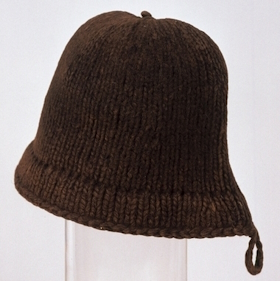 Headwear varied greatly and was very common in the society of the time. The importance of headwear is demonstrated by one incident when Benjamin Hornigold’s crew was reported to have stolen only the hats from one ship after throwing their own overboard while drunk. Hats and caps might have been black, coloured, checked, or spotted. Woollen and fur caps were popular among seamen. Seafarers since the 1570s favoured woollen hats, in particular the ‘Monmouth cap’, which was knitted from brown wool and was associated with the town of Monmouth in Wales. The rim could be turned up or down. These caps were very practical, keeping the head warm and dry, and not easily blowing off in the wind, but they might have been too warm for the tropics. Another popular type of headwear was a small, round, black hat made of felt or tarred canvas, which when cocked gave the sailor the appearance of wearing ‘a triangular apple pastry’ on his head. Leather, fur, and fur-trimmed cloth caps were also worn, as were thrums, made from the discarded ends of the weaver’s warp. The fabric was good for wearing in wet conditions. A thrum cap consisted of a canvas base in the shape of an inverted flower pot with woollen thrums pushed through to create a shaggy exterior. Such caps were worn by sailors in the Tudor period, and were commonly dyed blue or brown. They continued to be in use into the seventeenth century, but had probably gone out of fashion by the beginning of the 18th century.
Headwear varied greatly and was very common in the society of the time. The importance of headwear is demonstrated by one incident when Benjamin Hornigold’s crew was reported to have stolen only the hats from one ship after throwing their own overboard while drunk. Hats and caps might have been black, coloured, checked, or spotted. Woollen and fur caps were popular among seamen. Seafarers since the 1570s favoured woollen hats, in particular the ‘Monmouth cap’, which was knitted from brown wool and was associated with the town of Monmouth in Wales. The rim could be turned up or down. These caps were very practical, keeping the head warm and dry, and not easily blowing off in the wind, but they might have been too warm for the tropics. Another popular type of headwear was a small, round, black hat made of felt or tarred canvas, which when cocked gave the sailor the appearance of wearing ‘a triangular apple pastry’ on his head. Leather, fur, and fur-trimmed cloth caps were also worn, as were thrums, made from the discarded ends of the weaver’s warp. The fabric was good for wearing in wet conditions. A thrum cap consisted of a canvas base in the shape of an inverted flower pot with woollen thrums pushed through to create a shaggy exterior. Such caps were worn by sailors in the Tudor period, and were commonly dyed blue or brown. They continued to be in use into the seventeenth century, but had probably gone out of fashion by the beginning of the 18th century.
Pirates who preyed in Caribbean waters might have sometimes wore scarves, turbans, or hats of straw or felt with wide, floppy brims. Some pirates decorated their hats with plumes or jewels. Leather caps faced with cotton possibly with an upturned peak were also worn among seamen, as were stitched leather skullcaps. Dutch seamen wore tall hats with a narrow rim. French sailors wore long, red stocking caps. In warmer climates, wide brimmed slouch hats made of felt or straw were more suitable. The brim could be folded against the crown to allow better visibility or folded down to shade the eyes from the sun. A hat band was often decorated with a feather, or a tobacco pipe could be tucked into it. Cropped hats, which were slouch hats with the brim cut away leaving only the peak, ressembling a modern baseball cap, were also worn. The ‘Montero cap’ was popular in Spain in 17th century, although no-one knows exactly what it looked like. It is thought to have had a spherical crown and fur-lined flaps, which could be drawn down to protect the ears and neck. Tricorns, hats with the sides turned up giving them three corners, are the most popular piece of headwear in images of pirates, and they did indeed exist in the era, although but didn’t really become popular among seamen until the 1730s, although they were regularly worn on land before then. If worn at sea, the tricorn would have needed to have been smaller than on land so they didn’t get in the way so much, or weren’t blown off so easily. On the whole, they were impractical for working on a ship as they didn’t really protect the face from the sun, could easily catch on things, and collected and channelled rain water. Some Caribbean pirates might have worn headscarves knotted onthe forehead or at the back to protect their head from the sun and keep sweat out of eyes, and hair out of their face. They might have worn them under a hat, but no there’s no real evidence of widespread use of headscarves among pirates. In contrast, there is plenty of evidence that they wore neckerchiefs of varying colours around the neck, which was common practice at the time. Wigs were popular at that period, but were much too warm to be worn on a daily basis in the tropics, only being worn on formal occasions. By the 1720s wigs became less voluminous and more natural-looking.
Shirts
Shirts were originally viewed as an undergarment worn exclusively by men. They were made of linen, canvas, or cotton. They were normally thigh-length with narrow cuffs, to avoid getting caught on things, and their texture was rough. Sailors often wore chequered or striped shirts, but pirates might have worn plain white ones to distinguish themselves from common seamen. White shirts were usually not that common at sea as they couldn’t be washed and bleached so readily as they could on land. When in the Caribbean, where it was warm and sunny, they might not have worn a shirt at all, although it might have been advisable to wear one as protection from the scorching sun. Underwear wasn’t common at the time, although underbreeches did exist. Long linen shirts could be used for this purpose instead. They were open at the sides from the waist down, which allowed them to be tucked between the legs before putting on the trousers.
Trousers
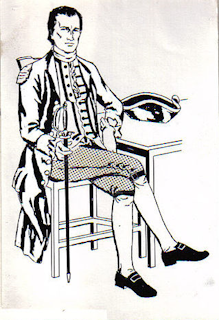 At the beginning of the of the 18th century, breeches were more common on land than trousers, which were gradually coming into fashion at the beginning of the 18th century. Long trousers were normally preferred for working in. A seaman’s trousers were made of linen or canvas, were usually coloured or striped, and had several pockets. As well as trousers reaching the ankles, there were two other main types. The first were baggy knee-length breeches, secured or open at the knees. Securing them held the stockings in place, but alternatively knee bands were used to hold stockings up as no elastic was available then. Breeches were buttoned at the front and had lacing at the back to tighten them at the waist. Because breeches were tight at knees and waist much room was needed for the posterior to allow for movement. The other common type of trousers were petticoat breeches, also called slivers or slops, which were a short pair of breeches with wide legs being loose at the knee, allowing air circulation. In cold weather, they could be worn over long trousers to protect them and to give added warmth. All trousers were generally loose fitting. Leather belts with small brass buckles were often worn with the purpose of holding pouches, a sword, or other items. Sashes were uncommon in the early 18th century, although they were popular in France and Spain and were worn by buccaneers of the 17th century.
At the beginning of the of the 18th century, breeches were more common on land than trousers, which were gradually coming into fashion at the beginning of the 18th century. Long trousers were normally preferred for working in. A seaman’s trousers were made of linen or canvas, were usually coloured or striped, and had several pockets. As well as trousers reaching the ankles, there were two other main types. The first were baggy knee-length breeches, secured or open at the knees. Securing them held the stockings in place, but alternatively knee bands were used to hold stockings up as no elastic was available then. Breeches were buttoned at the front and had lacing at the back to tighten them at the waist. Because breeches were tight at knees and waist much room was needed for the posterior to allow for movement. The other common type of trousers were petticoat breeches, also called slivers or slops, which were a short pair of breeches with wide legs being loose at the knee, allowing air circulation. In cold weather, they could be worn over long trousers to protect them and to give added warmth. All trousers were generally loose fitting. Leather belts with small brass buckles were often worn with the purpose of holding pouches, a sword, or other items. Sashes were uncommon in the early 18th century, although they were popular in France and Spain and were worn by buccaneers of the 17th century.
Jackets and coats
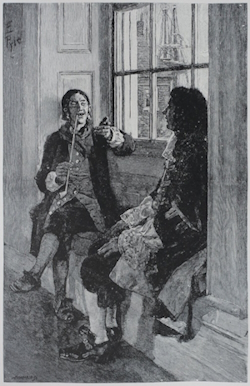 Jackets at the time were collarless and hip-length with flaring skirts. They were adorned with horn, leather, or metal buttons and had several pockets. They usually also had buttons on the sleeves. The colour of jackets varied and they could even be striped. At sea, jackets and coats were made of waterproof materials or were coated with tar. Although tarring them made them water-resistant on the outside, it also made the garment heavier, prevented sweat from escaping, and made them less comfortable to wear. Tarred garments were also liable to cracking, breaking down the fabric more quickly. One type of short, linen jacket was know as the ‘pea jacket’. According to a 1975 edition of The Mariner’s Mirror, the term ‘pea coat’ originated from the Dutch word pijjekker. The word pij referred to the type of cloth used, which was a coarse kind of twilled blue cloth with a nap on one side. Jakker was the word for a man’s short, heavy coat. Another theory, favoured by the US Navy, is that the heavy topcoat worn in cold, miserable weather by sailors was once tailored from “pilot cloth”, which is a coarse, stout kind of twilled blue cloth with the nap on one side. The name was sometimes shorten to P-jacket, thus the name pea jacket or coat, which has been in common use since the 1720s. Other jackets and coats were made of sailcloth or sackcloth. In bad weather, a long woollen smock called a ‘sea gown’ or a heavy coat called a ‘watch coat’ were often worn,. Pirate captains are often depicted as wearing long coats, but it was uncommon aboard a ship, especially in warmer climates, with coats normally being reserved for formal occasions or bad weather. Seamen also wore frock coats made of wool, or more commonly linen, which went down to the knees. They had wide sleeves, but no collars or lapels. Heavy coats, particularly ones made of wool, were good for colder climates like the east coast of North America and on the open sea, but much too warm for the Caribbean and west coast of Africa. Waistcoats were popular at the time, usually being long-skirted and with or without sleeves. They reached the waist, had no linings, collar, or lapel, and were often striped or patterned. They were designed to only be seen from the front, so backs and sleeves were usually made of cheaper material. Some were buttoned down the front, while others were tied with laces with pockets being at hip level.
Jackets at the time were collarless and hip-length with flaring skirts. They were adorned with horn, leather, or metal buttons and had several pockets. They usually also had buttons on the sleeves. The colour of jackets varied and they could even be striped. At sea, jackets and coats were made of waterproof materials or were coated with tar. Although tarring them made them water-resistant on the outside, it also made the garment heavier, prevented sweat from escaping, and made them less comfortable to wear. Tarred garments were also liable to cracking, breaking down the fabric more quickly. One type of short, linen jacket was know as the ‘pea jacket’. According to a 1975 edition of The Mariner’s Mirror, the term ‘pea coat’ originated from the Dutch word pijjekker. The word pij referred to the type of cloth used, which was a coarse kind of twilled blue cloth with a nap on one side. Jakker was the word for a man’s short, heavy coat. Another theory, favoured by the US Navy, is that the heavy topcoat worn in cold, miserable weather by sailors was once tailored from “pilot cloth”, which is a coarse, stout kind of twilled blue cloth with the nap on one side. The name was sometimes shorten to P-jacket, thus the name pea jacket or coat, which has been in common use since the 1720s. Other jackets and coats were made of sailcloth or sackcloth. In bad weather, a long woollen smock called a ‘sea gown’ or a heavy coat called a ‘watch coat’ were often worn,. Pirate captains are often depicted as wearing long coats, but it was uncommon aboard a ship, especially in warmer climates, with coats normally being reserved for formal occasions or bad weather. Seamen also wore frock coats made of wool, or more commonly linen, which went down to the knees. They had wide sleeves, but no collars or lapels. Heavy coats, particularly ones made of wool, were good for colder climates like the east coast of North America and on the open sea, but much too warm for the Caribbean and west coast of Africa. Waistcoats were popular at the time, usually being long-skirted and with or without sleeves. They reached the waist, had no linings, collar, or lapel, and were often striped or patterned. They were designed to only be seen from the front, so backs and sleeves were usually made of cheaper material. Some were buttoned down the front, while others were tied with laces with pockets being at hip level.
Footwear
Shoes of the period were generally plain cowhide or pigskin leather slip-on ones with rounded toes, possibly with a buckle, which, being expensive, were often taken from an old pair and and put onto a new one. Laced shoes were rare then. On land, shoes usually had heels and tended to have a square toe. They were adorned with small buckles and had large tongues that were sometimes turned down at the top. Half-boots, which reached up to the ankle were probably more common on land than on board a ship and were more expensive. Since the 17th century, most leather shoes had a sewn-on sole, which remained standard until around 1800. Welted rand shoes were commonly made without differentiation between the left or right foot. Such shoes are now referred to as ‘straights’. Knee-high socks or stockings of linen, wool, or silk were usually worn, but no socks or going barefoot were probably preferred in warmer climates. The cuffed-knee high boots of Hollywood images would have been impractical on a ship and were generally worn by cavalrymen and fishermen. They weren’t particularly fashionable at the time. One problem with leather shoes at sea was that they were prone to damage from the salt in sea water, causing them to fall apart more quickly, so cheap shoes were preferred.
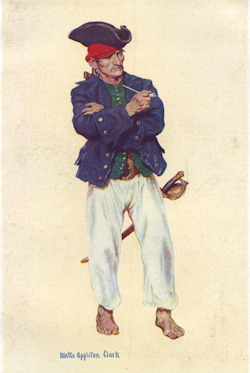 All in all, pirates probably wore a mix of garments and headwear, depending on what they found, often relying on what they could plunder or make themselves. Clothes were hard to come by and may often have been patched and sewn with a variety materials, having various different buttons of metal, bone, and wood on the same item of clothing. As very few pirate ships had tailors on board the quality of the self-made clothes would have varied greatly, although the ability to sew was much more widespread then, especially among seamen. Only usually possessing one set of clothes, pirates probably would have kept them until they were completely worn out and beyond repair. We should also bear in mind that there were very few opportunities for washing clothes at sea, only sea water being available, so clothes would have been constantly caked with salt, being kept damp by rain and sea spray as well as being smelly from sweating caused by heat and labour. Although it can be concluded that the average pirate was virtually indistinguishable from the common seaman, some, in particular pirate captains, might have tried to imitate the gentlemen of the time: Bartholomew Roberts wore a wig and red coat and had a penchant for silks and satins; Jack Rackham liked to wear colourful garments of calico, giving him his well-known nickname.
All in all, pirates probably wore a mix of garments and headwear, depending on what they found, often relying on what they could plunder or make themselves. Clothes were hard to come by and may often have been patched and sewn with a variety materials, having various different buttons of metal, bone, and wood on the same item of clothing. As very few pirate ships had tailors on board the quality of the self-made clothes would have varied greatly, although the ability to sew was much more widespread then, especially among seamen. Only usually possessing one set of clothes, pirates probably would have kept them until they were completely worn out and beyond repair. We should also bear in mind that there were very few opportunities for washing clothes at sea, only sea water being available, so clothes would have been constantly caked with salt, being kept damp by rain and sea spray as well as being smelly from sweating caused by heat and labour. Although it can be concluded that the average pirate was virtually indistinguishable from the common seaman, some, in particular pirate captains, might have tried to imitate the gentlemen of the time: Bartholomew Roberts wore a wig and red coat and had a penchant for silks and satins; Jack Rackham liked to wear colourful garments of calico, giving him his well-known nickname.
If you would like to find out more about clothing at the beginning of the 18th century, I highly recommend the informative video below by Nicole Rudolph.
